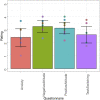VIPCare: Understanding the support needed to create affective interactions between new caregivers and residents with dementia
- PMID: 35096413
- PMCID: PMC8796076
- DOI: 10.1177/20556683211061998
VIPCare: Understanding the support needed to create affective interactions between new caregivers and residents with dementia
Abstract
Introduction: In this paper, we study the support needed by professional caregivers of those with dementia, and present a first step toward development of VIPCare, a novel application with the goal of assisting new caregivers at care-centres in interacting with residents with dementia.
Methods: A mixed-methods study including two questionnaires, two focus groups, and seven co-design sessions with 17 professional caregivers was conducted to (a) understand caregivers' challenges/approaches used to reduce negative interactions with persons with dementia, (b) identify the existing gaps in supporting information for improving such interactions, and (c) co-design the user interface of an application that aims to help improve interactions between a new professional caregiver and persons with dementia. A pre-questionnaire assessed knowledge of smartphones and attitude toward technology. A post-questionnaire provided an initial evaluation of the designed user interface.
Results: Focus groups emphasized the importance of role-playing learned through trial and error. The layout/content of the application was then designed in four iterative paper-prototyping sessions with professional caregivers. An iOS/Android-based application was developed accordingly and was modified/improved in three iterative sessions. The initial results supported efficiency of VIPCare and suggested a low task load index.
Conclusions: We presented a first step toward understanding caregiver needs and developing an application that can help reduce negative interactions between professional caregivers and those with dementia.
Keywords: dementia; paper-prototyping; participatory design; quality of life; user-centred design.
© The Author(s) 2022.
Conflict of interest statement
Declaration of conflicting interests: The author(s) declared no potential conflicts of interest with respect to the research, authorship, and/or publication of this article.
Figures






References
-
- Rose Addis D, Tippett L. Memory of myself: autobiographical memory and identity in alzheimer’s disease. Memory 2004; 12(1): 56–74. - PubMed
-
- Francis LE, Adams RE, Konig A, et al. Identity and the self in elderly adults with alzheimers disease. In: Identities in everyday life. Oxford, UK: Oxford University Press; 2019.
-
- Duffy M, Armenia A, Stacey CL. 1. on the clock, off the radar: paid care work in the united states. In: Caring on the clock. New Brunswick, NJ: Rutgers University Press; 2015, pp. 3–13.
-
- Sherman R. 14. caring or catering? Emotions, autonomy, and subordination in lifestyle work. In: Caring on the clock. New Brunswick, NJ: Rutgers University Press; 2015, pp. 165–176.
-
- Beard RL, Fox PJ. Resisting social disenfranchisement: negotiating collective identities and everyday life with memory loss. Soc Sci Med 2008; 66(7): 1509–1520. - PubMed
LinkOut - more resources
Full Text Sources

